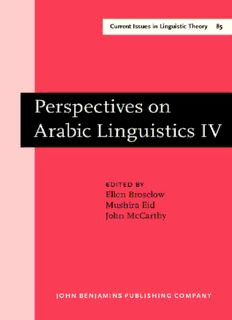
Perspectives on Arabic Linguistics: Papers from the Annual Symposium on Arabic Linguistics. Volume IV: Detroit, Michigan 1990 PDF
Preview Perspectives on Arabic Linguistics: Papers from the Annual Symposium on Arabic Linguistics. Volume IV: Detroit, Michigan 1990
PERSPECTIVES ON ARABIC LINGUISTICS IV AMSTERDAM STUDIES IN THE THEORY AND HISTORY OF LINGUISTIC SCIENCE General Editor E.F. KONRAD KOERNER (University of Ottawa) Series IV - CURRENT ISSUES IN LINGUISTIC THEORY Advisory Editorial Board Henning Andersen (Los Angeles); Raimo Anttila (Los Angeles) Thomas V. Gamkrelidze (Tbilisi); John E. Joseph (College Park, Md.) Hans-Heinrich Lieb (Berlin); Ernst Pulgram (Ann Arbor, Mich.) E. Wyn Roberts (Vancouver, B.C.); Danny Steinberg (Tokyo) PERSPECTIVES ON ARABIC LINGUISTICS IV PAPERS FROM THE FOURTH ANNUAL SYMPOSIUM ON ARABIC LINGUISTICS Edited by ELLEN BROSELOW State University of New York Stony Brook, N.Y. MUSHIRA EID University of Utah Salt Lake City, Utah JOHN MCCARTHY University of Massachusetts Amherst, Mass. JOHN BENJAMINS PUBLISHING COMPANY AMSTERDAM/PHILADELPHIA 1992 Library of Congress Catalog Serial Number: 91-641663 ISSN 0304-0763 ISBN 90 272 3582 1 (Eur.)/l-55619-140-5 (US) © Copyright 1992 - John Benjamins B.V. No part of this book may be reproduced in any form, by print, photoprint, microfilm, or any other means, without written permission from the publisher. Table of Contents Foreword vii Introduction 1 I. ARABIC DIALECTS: IMPLICATIONS FOR GENERAL LINGUISTICS Parametric Variation in Arabic Dialect Phonology 7 Ellen Broselow Vowel Shortening in Two Arabic Dialects 47 Mahasen Abu-Mansour Extra-Arabic Affiliations of k-Yemeni 77 David Testen Shifting Boundaries: The effect of MSA on dialect convergence in Baghdad 91 Farida Abu-Haidar Pronouns, Questions, and Agreement 107 Mushira Eid Cairene Arabic Auxiliaries and the Category AUX 143 John Eisele II. SOCIOLINGUISTIC PERSPECTIVES How Different are Men and Women: Palatalization in Cairo 169 Niloofar Haeri Vi TABLE OF CONTENTS A Sociolinguistic Description of (u:) in Korba Arabic: Defining linguistic variables in contact situations and relic areas 181 Keith Walters Code-Mixing in the Speech of Arabic-English Bilinguals 219 Ahmad Atawneh III. HISTORICAL PERSPECTIVES Variable Agreement with Nonhuman Controllers in Classical and Modern Standard Arabic 245 R. Kirk Belnap & Osama Shabaneh Morphosyntactic Analysis in Al-Jumalfii l-nahw: Discourse structure and metalanguage 263 Karin Ryding Index of Subjects 279 FOREWORD On March 2-3, 1990 the Fourth Annual Symposium on Arabic Linguistics was held at Wayne State University in Detroit. The symposium was sponsored by the Arabic Linguistic Society, Wayne State University's Department of Near Eastern and Asian Studies, Office of the Dean of Liberal Arts, and Linguistics Program, together with the University of Utah's College of Humanities, Department of Languages and Literature, and Linguistics Program. A total of 16 papers were presented at the symposium; of these, 11 are published in this volume. The papers presented at the symposium were selected on the basis of an anonymous review of abstracts submitted to the Program Committee. The papers inlcuded in the volume were further reviewed by the editors before their final acceptance for publication. The transcription of all Arabic materials in the body of the papers follows the International Phonetic Alphabet or standard equivalents. The Arabic emphatics, however, are represented by a dot underneath the symbol, and long vowels as sequences of two vowels. The transliteration of Arabic names and titles follows accepted formats, with some simplification in the use of diacritics. We have used ' and ' for hamza (glottal stop) and 'ayn (pharyngeal approximant), respectively. In quoted materials we followed the original text. The preparation and printing of the final manuscript was done using facilities available at the Middle East Center of the University of Utah, Salt Lake City. We would also like to acknowledge the editorial assistance of Eric Olson, a student of Linguistics and Arabic Linguistics at the University of Utah. INTRODUCTION Ellen Broselow Mushira Eid John McCarthy This volume includes papers from the parasession on the study of Arabic dialects and their implications for general linguistics, as well as papers from the general session. Because the Arabic dialects are similar in many ways, a study of the ways in which they differ can help isolate precisely the range of permissible interlinguistic variation (i.e., the 'parameters' of universal grammar). While a number of the papers in the first section focus on the contribution of dialect studies to a theory of possible cross-dialectal and cross-linguistic variation, others focus on individual dialects, thus providing data and analyses that can further contribute to our understanding of this type of variation. In the first paper (and the keynote address to the symposium), Broselow presents a study of syllabic phonlogy in Cairene, Sudanese, Makkan, and Iraqi Arabic. Broselow argues that syllable bimoraicity is a fundamental organizing principle in all these dialects, with phonological processes of various kinds functioning to realize this principle. Apparent variation in the directionality of syllable- dependent operations, she argues, actually follows from the option allowed in some dialects of assigning a consonant to a syllable nucleus. The choice of this option determines several apparently independent features of dialect phonology.
Description: